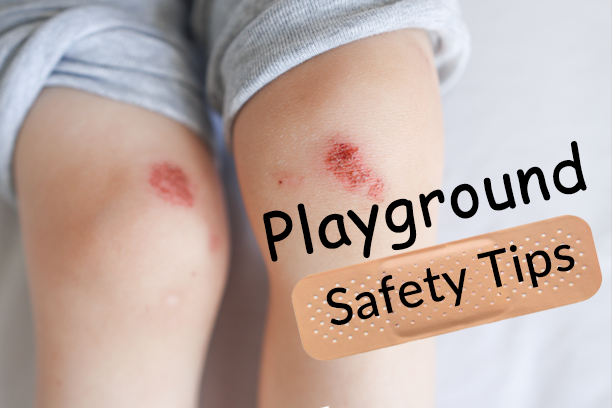Playgrounds are spaces of joy and adventure, but they can also present potential hazards. As parents, caregivers, or concerned members of the community, we all share a common goal: ensuring the well-being and happiness of our children. One of the places where they find boundless joy and learn valuable life skills is on the playground. Here are tips for playground safety.
According to the Consumer Product Safety Commission (CPSC), each year, more than 220,000 children ages 14 and younger go to U.S. hospital emergency departments with injuries associated with playground equipment.
57% of estimated playground-related injuries treated in ERs occurred at either schools or parks. Nearly 80% of playground injuries are caused by falls.
CPSC investigated 40 deaths between 2001 and 2008. Of these:
- 68% were the result of hanging/asphyxiation
- 7% were caused by neck/head injuries
- The rest were due to other causes.
More than 20,000 of these children are treated for a traumatic brain injury, including concussion.
Parents, caregivers, and guardians should be vigilant and proactive in supervising their little ones. Here are some essential safety tips and warnings to keep in mind:
CAUTION: Recognize that the available information contained herein is partial and inconclusive due to the multitude of known and unknown variables and probabilities.
GENERAL TIPS
Choose the Right Play Area Based on Your Child’s Age
- Children of different ages have varying play styles. It’s crucial to designate a distinct play space for those under 5, equipped with age-appropriate playground structures.
- For infants taking their first steps, the play area should feature a smooth and manageable walking surface.
- Even in areas designated for specific age groups, parents and caregivers must maintain a vigilant level of awareness. Just because an area is designated as ‘age-appropriate,’ it doesn’t mean they should lower their guard.
Supervise Kids Using Playground Equipment.
- Supervising children actively on the playground should be straightforward. They’ll likely call out for your attention as they climb, jump, and swing. Make sure to focus on them, not your phone.
- When choosing a playground, opt for ones with surfaces like rubber, synthetic turf, sand, pea gravel, wood chips, or mulch that absorb shock. In case of a fall, these materials provide a softer landing compared to asphalt, concrete, grass, or dirt.
- Ensure your attire is suitable for the playground. Remove items like necklaces, purses, scarves, or clothing with drawstrings that could potentially get caught on equipment, posing a strangulation risk. Helmets, typically reserved for biking, can also be hazardous on the playground.
- Teach children the importance of avoiding pushing, shoving, aggressive behavior, or overcrowding while on the playground, as it can lead to potential dangers.

If you are using your phone for any reason instead of watching a child, ask yourself this: “What is more important- this phone or my child’s safety”?
Ensure Safe Surfacing Beneath and Surrounding Playground Equipment
- Steer clear of playgrounds featuring surfaces that do not absorb impact, such as asphalt, concrete, grass, dirt, or gravel.
- Preferred surface materials may encompass sand, pea gravel, wood chips, mulch, and shredded rubber. Safety-tested rubber mats, synthetic turf, and other artificial materials also offer secure surfaces and entail lower upkeep.
- The surfacing should be, allegedly, a minimum of 12 inches deep and extend at least 6 feet in all directions around immobile equipment. Depending on the equipment’s height, the surfacing may need to extend beyond 6 feet.
- Playgrounds should have no exposed concrete footings, rocks, or tree stumps.
- Avoid overcrowding in play areas: The space beneath and around play equipment should be at least 6 feet in all directions, while the area around swing sets should be twice the height of the hanging bar both in front and behind the swings. Structures surpassing 30 inches in height should be positioned at least 9 feet apart.
- Unprotected elevated zones: Platforms exceeding 30 inches should be equipped with guardrails or barriers.
- Mind head entrapment spaces: Gaps between rails, bars, rungs, and even ropes in cargo nets should measure no less than 3 1/2 inches and no more than 9 inches (also detailed in Climbing Equipment Safety below).
- Eliminate sharp points and edges: Playground equipment should be devoid of protruding bolt ends, “S” hooks, and any other sharp points and edges.
Check That Playgrounds Are Inspected and Maintained by Qualified Personnel
- Please verify with your HOA, school, and childcare center to ensure they possess age-appropriate, properly maintained playground equipment.
- In case you come across any hazards in a public, HOA-managed, or backyard playground, promptly notify the relevant authority and refrain from allowing children to use the equipment until it has been deemed safe.
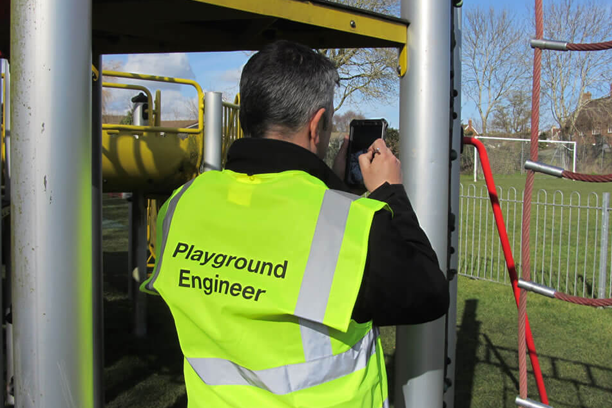
Common Sense Tips
- Always ensure there are no other children in the vicinity before allowing them to jump off equipment or slide, and emphasize landing on both feet with slightly bent knees.
- Keep bikes, backpacks, and bags away from the equipment and play area to prevent tripping hazards.
- When riding bikes, skateboards, scooters, or any wheeled device, always wear a helmet, but remove it when on playground equipment.
- Avoid using wet playground equipment as moisture makes surfaces slippery.
- During the summer, check playground equipment for excessive heat, especially metal slides, handrails, and steps, which can become uncomfortably or even dangerously hot. Contact burns can occur rapidly. Use prudent judgment — if the equipment feels hot to the touch, it’s likely unsafe and not enjoyable to play on.
- Opt for clothing without drawstrings or cords, as these items can get caught on equipment and pose a risk of accidental strangulation.
- Apply sunscreen when playing outside, even on cloudy days, to guard against sunburn.
SPECIFIC ITEMS SAFETY TIPS
SEESAW SAFETY
- Using a seesaw safely requires cooperation among children. It’s generally advised not to let preschoolers use a seesaw unless it’s equipped with a spring-centering device beneath the seat to prevent sudden contact with the ground. Regardless of the specific design, both seesaws and merry-go-rounds should be approached with caution.
- Seesaw seats, much like swings, are designed for one child per seat. If a child is too light to seesaw with a partner, they should seek out a different partner rather than adding another child to their side of the seesaw.
- It’s important for children to always sit facing each other, rather than turning around.
- Teach kids to hold on tightly with both hands while on a seesaw, avoiding any contact with the ground or attempts to push off with their hands. Also, remind them to keep their feet to the sides and out from underneath the seesaw.
- Children should stand a safe distance away from a seesaw when it’s in use. They should never stand beneath a raised seesaw, try to rock it in the middle, or attempt to climb onto it while it’s in motion.
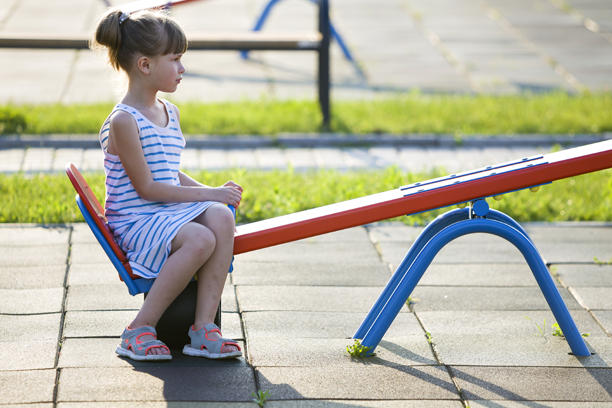
SWING SAFETY
- Ensure that there is a cleared space both in front of and behind the swing, as well as a shock-absorbent surface below it, all measuring twice the height of the hanging bar.
- Maintain a minimum distance of 6 feet between walls, fences, and any other objects on either side of the swing.
- Opt for swing seats crafted from soft materials like rubber, plastic, or canvas.
- Confirm that open or “S” hooks on swing chains are securely closed, forming a figure-eight shape.
- Securely anchor swing sets to prevent tipping.
- Avoid placing swings too close together; allegedly, maintaining a spacing of at least 24 inches between swings. In any given section of the structure, limit the number of seat swings to no more than two, or one tire swing.
- Discourage children from swinging on their stomachs or leaping off. Teach them to refrain from running in front of swings while others are using them.
- For swings, consider extending the surfacing both in front of and behind the hanging bar to twice its height. For example, if the top of the swing set measures 10 feet, the surfacing should extend for 20 feet.
- Select swings made of soft materials like rubber or plastic, avoiding wood or metal.
- Advise children to always sit in the swing, rather than standing or kneeling. They should firmly grasp the swing with both hands while in motion and, when finished, come to a complete stop before dismounting.
- Children should maintain a safe distance from others on swings, being cautious not to pass in front of or behind a swing in motion.
- Children should never share a swing with more than one person. Swings are designed for the safe use of one person at a time.
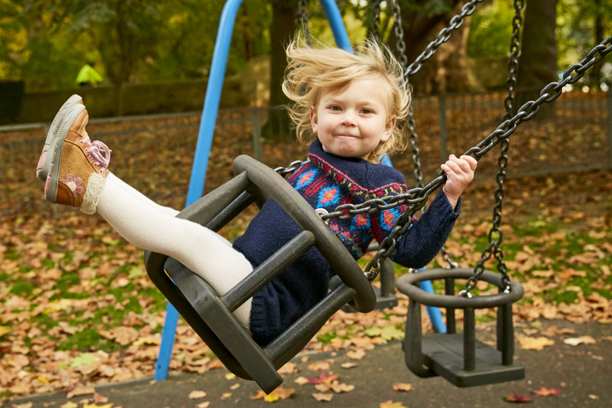
SLIDE SAFETY
- Encourage children to ascend the ladder step by step, gripping the handrail securely as they climb towards the slide’s summit. Discourage them from attempting to climb directly on the sliding surface to reach the top.
- Instruct kids to always descend the slide in a seated position, going feet-first and upright, avoiding head-first, supine, or prone positions.
- Emphasize that only one child should occupy the slide platform at any given time, and group sliding should be avoided.
- Prior to sliding down, children should verify that the slide’s base is clear of any obstructions. Upon reaching the bottom, they should promptly exit the slide area. Teach your child to ensure that anyone in front of them has fully descended before proceeding.
- Be cautious of metal slides, as they can become scorching hot from sun exposure and cause severe burns to a child’s hands and legs. Plastic slides can also heat up significantly. On sunny days, seek out playgrounds where slides are shaded.
- Ensure that slides feature a top platform with secure handrails for children to grasp. Additionally, there should be a guardrail, canopy, or similar structure at the top to enforce sitting before sliding down. Open slides should, ideally, have sides that are at least 4 inches in height.
- Inspect the slide area for potential hazards such as rocks, sand, glass, sticks, toys, debris, or other children, as these could obstruct a safe landing.
- Avoid descending the slide with a child on your lap. Despite the appearance of safety while holding them, research indicates that children’s limbs or digits often become entangled and injured during the descent.

CLIMBING EQUIPMENT SAFETY
- Climbing equipment comes in various forms, such as rock climbing walls, arches, and both vertical and horizontal ladders. It poses a greater challenge for kids compared to other playground equipment.
- Ensure that your children are knowledgeable about a safe descent method in case they are unable to complete the climb. Climbing equipment has a higher risk of causing injuries when not used or designed correctly. Supervision by adults is particularly crucial for younger children.
- Teach and emphasize to kids the importance of using both hands and maintaining a safe distance from the person ahead of them. They should also be cautious of swinging feet.
- When children release their grip from the bars, they should be able to land without making contact with the equipment on the way down. Remind them to keep their knees bent and touch down with both feet.
- Platforms exceeding 30 inches above the ground and meant for school-aged children should be equipped with guardrails or barriers to prevent falls.
- Gaps, whether vertical or horizontal, like those between the ropes of cargo nets, should be no less than 3½ inches wide and no more than 9 inches wide, as stated earlier in this post. This ensures that a small child’s hands or head won’t get trapped while also preventing them from slipping through easily.
- Stairs, steps, and rungs—the horizontal supports for ladder climbing—should be uniformly spaced. Round rungs designed for young hands to grip should be approximately 1 to 1½ inches in diameter.
- Check for any sharp points or edges. In wooden structures, inspect for protruding nails or screws. Metal structures should be free of rust or peeling paint, which may contain lead.
- Avoid letting your child wear or interact with anything that could become entangled in the equipment and pose a strangulation risk. This includes items like sweatshirts with drawstrings or necklaces. Additionally, keep jump ropes and pet leashes away from the equipment.
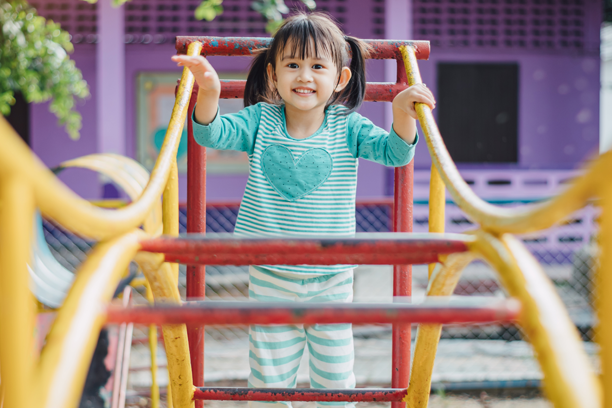
Hopefully this post helps some parents and children to be more safe and potentially avoid injuries at playgrounds!
Thoughts of Selling or Buying a Home?
Call/Text Tony at 949-633-6741
or Click here to send a message!

